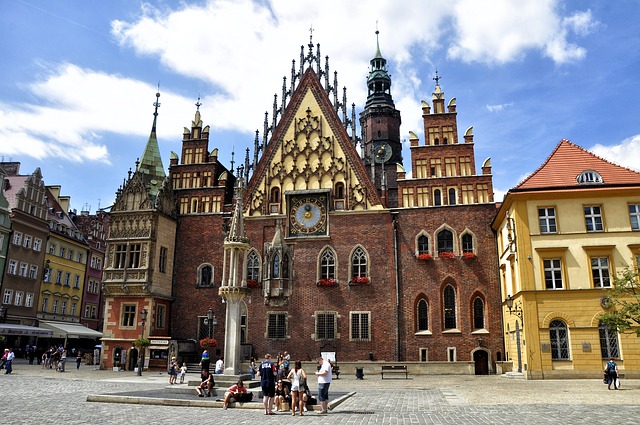By Tim Lambert
Early Wroclaw
Wroclaw is one of Poland’s great cities. It began in the 10th century as a settlement on an island called Ostrow Tumski (Cathedral Island). In 990 Silesia and Wroclaw became part of Poland. In 1000 a bishopric (diocese of a bishop) was established there.
In 1241 Wroclaw was devastated when the Mongols invaded Eastern Europe. However, the town was rebuilt south of the River. A market square was laid out and the town flourished again. (Wroclaw Market Square, The Rynek is the second-largest market square in Europe). Then in 1335, Wroclaw came under Czech rule.
The oldest church in Wroclaw is the Church of St Giles, which was built about 1230. The Church of Saints Wenceslas, Stanislaw, and Dorothy was founded in 1351. Saint Wenceslas was Czech, Stanislaw was Polish and Dorothy was German. The three saints represented the three nationalities living in the town. St Elizabeth’s Church also dates from the 14th century.
Wroclaw grew larger under Czech rule but in 1526 it became part of the Hapsburg Empire. Meanwhile, the Cathedral of St John the Baptist was built between the 13th century and the 16th century. Wroclaw Town Hall was rebuilt in the 13th century but later modified. The astronomical clock was built in 1580. The Church of the Holy Name of Jesus was built in the 1690s.
Modern Wroclaw
In 1741 Frederick the Great of Prussia took Silesia. Wroclaw then became part of Prussia and its name was changed to Breslau. Later it became part of Germany. In the late 19th century Germany industrialized and Wroclaw grew rapidly. Its industries boomed.
Meanwhile, an academy was founded in 1702. In 1811 it became Wroclaw University. Also in 1811 Wroclaw Botanical Garden was founded. Meanwhile, in 1785, Szczytnicki Park was laid out. It was destroyed during the Napoleonic Wars but became a park again afterward. In 1810 one of the tributaries of the River Odra was filled in and Cathedral Island ceased to be an island.
The Jewish Cemetery in Wroclaw was founded in 1856. (Wroclaw had a large Jewish community). Wroclaw Main Railway Station was built in 1857. Sand Bridge was built in 1861 and Wroclaw Zoo began in 1865. Tumski Bridge was built in 1890.
Partynice Racecourse opened in 1907. Hala Targowa (Market Hall) was built in 1908 and the Centennial Hall was built in 1913. Also in 1913, the Japanese Garden was founded.
During the Second World War, the Germans turned Wroclaw into a fortress. It withstood a long siege by the Russians in 1945 during which most of the city was destroyed Wroclaw finally surrendered on 6 May 1945.
When Germany surrendered Wroclaw was handed back to Poland. The remaining Germans were expelled and the city was slowly rebuilt. The Panorama of Raclawice was made in 1894 and it went on display in Wroclaw in 1985. Wroclaw suffered a severe flood in 1997 but it soon recovered. In 1999 a monument to the victims of the massacre at Katyn in 1940 was erected.
Magnolia Park retail center opened in 2007. Wroclaw Fountain was built in 2009. A concrete sculpture called the Chair was erected in 2011. Also in 2011, Wroclaw Stadium opened. Sky Tower was built in 2012. Wroclaw was the European Capital of Culture in 2016.

Today Wroclaw is a thriving city. Wroclaw is a manufacturing center and hi-tech industries are developing. Tourism in Wroclaw is also thriving. In 2025 the population of Wroclaw was 674,000.
Last revised 2025